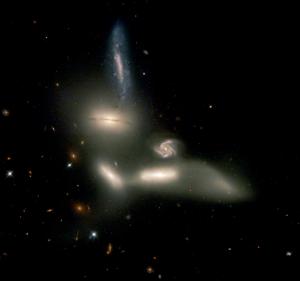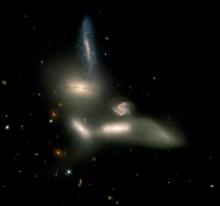Seyfert’s Sextet [1]
Many regions of the night sky look fairly dark and empty. They look that way because they don’t contain any of the bright planets of our solar system, or any stars that are close and bright. If you look deeper into those regions, though, you’re almost certain to come across a cosmic wonder — something that’s both beautiful and intriguing.
An example is a small group of galaxies known as Seyfert’s Sextet. It’s in the west as night falls, in Serpens, the serpent — one of those regions that looks dark and uninteresting.
Seyfert’s Sextet is about 200 million light-years away — far outside our home galaxy, the Milky Way. It’s named for astronomer Carl Seyfert, who discovered the sextet almost seven decades ago.
The sextet is a bit deceiving. One of its galaxies is actually a background object — it’s hundreds of millions of light-years farther than the others. And what looks like two galaxies is really two parts of a single galaxy.
Even so, it’s a fascinating group. The four galaxies are so close together that they’re interacting — each galaxy’s gravity is having an effect on the others. The interaction has pulled a huge streamer of stars out of one of the galaxies, for example, making it look like two galaxies. It’s also triggering the birth of many new stars.
Over the next few billion years, the four galaxies are likely to merge. They’ll form a single super galaxy — an impressive sight far from our own cosmic neighborhood.
Script by Damond Benningfield


